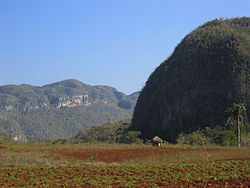- Mogote
-
Mogotes are isolated, steep-sided, residual, hills, which are composed of either limestone, marble, or dolomite and surrounded by nearly flat alluvial plains. These hills typically have a rounded, tower-like form. This term was originally used for karst hills developed in the folded limestone in the Sierra de los Organos, Cuba. This term is now used internationally for karst hills, which are surrounded by alluvial plains, in the Tropics regardless of whether the carbonate strata in which they have formed is folded or not.[1][2]
-
View of Viñales Valley in Pinar del Río Province, Cuba.
-
Eastern view of the mogotes in Viñales.
References
- ^ Neuendorf, K. K. E., J. P. Mehl, Jr., and J. A. Jackson, 2005, Glossary of Geology, 5th ed. American Geological Institute, Alexandria, Virginia. 779 p. ISBN 0-922152-76-4
- ^ U.S. Environmental Protection Agency, 2002, A Lexicon of Cave and Karst Terminology with Special Reference to Environmental Karst Hydrology (2002 Edition). U.S. Environmental Protection Agency, Office of Research and Development, National Center for Environmental Assessment, Washington Office, Washington, D.C., EPA/600/R-02/003. 221 p.
Other References
- Day, M. J. (March 1978). "Morphology and distribution of residual limestone hills (mogotes) in the karst of northern Puerto Rico". Geological Society of America Bulletin 89 (3): 426–32. http://bulletin.geoscienceworld.org/cgi/content/abstract/89/3/426.
Categories:- Geomorphology
- Landforms of Cuba
- Erosion landforms
- Regional geology stubs
Wikimedia Foundation. 2010.




